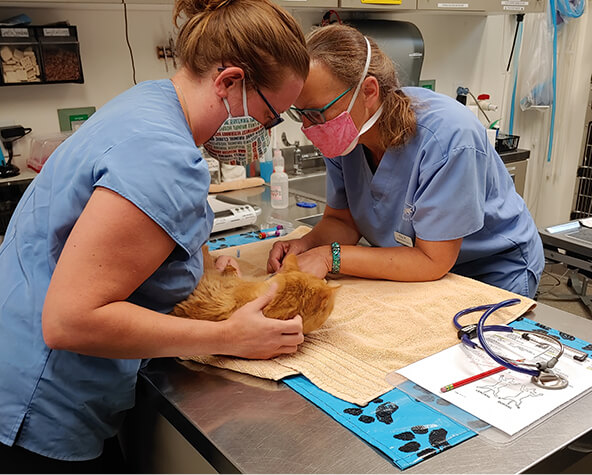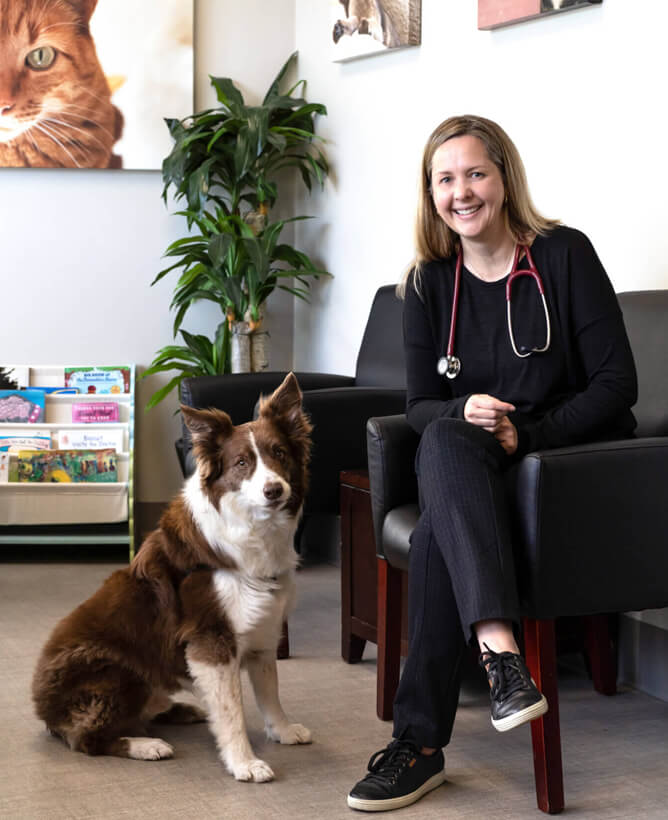
Our top priority is making sure your pet is safe.
– Our skilled doctors will develop a surgical, anesthetic, and pain management plan customized to your pet.
– We want to keep your pet safe, calm, and comfortable throughout their visit.
– Pre-surgical physical examination is a necessary first step to every pet’s anesthetic plan.
– Blood tests are recommended for all of our patients prior to procedures to increase the chance of detecting unknown illness that can make anesthesia dangerous.
Your pet’s safety is our number one priority.
The first step in any health care plan is for our caring doctors take the time to assess your pet physically. During this visit the doctor will perform a physical exam and talk with you about your concerns for your pet. Based on the findings and your conversation as well as taking into account your pet’s breed, age, and previous medical history they may advise an anesthetic procedure as the best option for your pet. If this is the case, they may also recommend additional laboratory testing prior to anesthesia. Once all of the information has been gathered the doctor will follow the most up-to-date research and recommendations to develop a surgical, anesthetic, and pain management plan customized to your pet. With careful consideration toward keeping your pet safe, calm, and comfortable throughout their visit our doctors prepare their plan to balance the ideal selection of sedatives, pain medications, local and regional treatments, and injectable or inhaled general anesthetics. Because each procedure and anesthetic plan is personalized the process described here may differ slightly for your pet.
Hospital admission is a valuable part of the pre-anesthetic process.
Events involving anesthesia are often planned at least a few weeks in advance. Every owner will receive a reminder in the days prior to the procedure through email, text, or phone call to remind them of the time and location for presenting their pet in and to go over the guidelines, which include not feeding your pet after 10 PM the night before the procedure. The next crucial stage in ensuring your pet’s safety during surgery is the admissions procedure.This is our final check in to make sure the surgical plan we have in place matches your understanding of what your pet needs, that we know when your pet was last fed, which medications have or have not been given, and collect any other important information– including a way to contact you with any additional questions, clarifications, or updates while your pet is with us.
The process for general anesthesia.
Only licensed veterinarians and veterinary technicians are allowed to prepare and administer anesthetic medications in order to protect your pet’s safety. Typically, the first stage of anesthesia induction starts with an injection that sedates and relieves discomfort in your pet both during and after the treatment. Your pet will be given an intravenous (IV) catheter while feeling at relaxed thanks to the moderate sedative. Once the IV is set up, your pet will get a second sedative through the IV to enable the passage of an endotracheal tube. The general anesthetic gas is administered using the endotracheal (ET) tube.
Supportive measures we use to keep your pet safe.
We will only address the specific safety precautions related to surgery among the numerous general safety procedures in place inside the hospital that affect surgical patients. The installation of the IV catheter, which is used to administer intravenous fluids, is the first and most important safety precaution. In addition to helping your pet eliminate the anesthetic drugs from their body following surgery, the fluids support your pet’s blood pressure. The IV catheter also makes it possible to administer routine or emergency drugs directly into your pet’s vein.
An ET tube is inserted so that it closes off your pet’s airway because they are unable to swallow while under anesthesia. This ensures that your pet does not breathe in fluids or foreign objects while dozing, which could result in aspiration pneumonia. By delivering oxygen together with the anesthetic gas through the ET tube, we are able to maintain a safe level of blood oxygen in the patient.
Last but not least, we also employ forced-air warming blankets and circulating warm water pads to assist your pet in maintaining their body temperature and improving blood circulation. Both of these warming techniques were created with the safety of immobile patients in mind, as they do away with the risk of contact burns that many other methods have been known to produce.
Our attentive monitoring is an essential part of your pet’s health.
Before any medications are given, your pet will have a quick physical examination and two checks of their vital signs after being hospitalized. Your pet is assigned a staff member when the first dose of medication is administered. That team member will stay by your pet’s side until they start to nod off and become drowsy. Until monitoring leads can be attached, a staff member will manually check your pet’s vital signs while the IV catheter and ET tube are being installed. Blood pressure, body temperature, blood oxygen and carbon dioxide levels, respiratory and cardiac rate, and heartbeat pattern are all monitored and recorded using the same equipment used in human medicine. Throughout your pet’s procedure their vitals are viewed routinely by the doctor, technician, and/or assistant involved with your pet’s procedure and also documented at regular intervals. By keeping a record of your pet’s vitals trends are quickly noted and can be acted on before they become a problem. At the end of the procedure your pet is removed from inhalant anesthesia and begins the recovery process. A staff member continues to monitor your pet as they wake up removing their ET tube, continuing to check their vital signs, reflexes, and alertness. Monitoring tapers off in intensity as their mobility and awareness improves until they are able to comfortably go home.
Post Anesthetic Care Matters
Before you take your pet home one of our staff members will review your pet’s post-anesthetic care needs. You will get a printed document with this information as well. Not every anesthetic procedure requires a follow-up visit but if yours does we will let you know and you can schedule when you pick up your pet. Each day we have a doctor available for phone consultation until 9 PM. If your pet had a procedure and you have questions you can call our doctor for guidance. We will also follow up with a phone call the next day to check on your pet and answer any new questions you have.
If your pet is in need of surgery to improve its health and needs anesthesia as part of that process, we can help. Schedule an appointment today.

Northwest Veterinary Hospital
Call/Text: 206-545-4255
Fax: 206-545-4205
